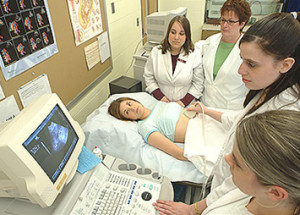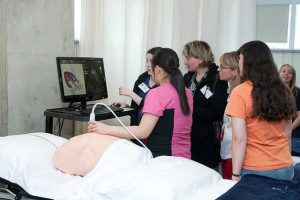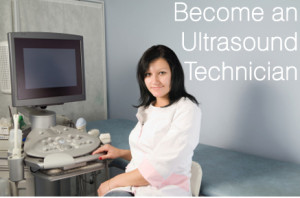An ultrasound technician, also called a diagnostic medical sonographer or just a sonographer, uses what is called an ultrasound scanner to examine the inner organs of the body, as well as tissues and blood flow. Ultrasound scanners are comprised of a computer console with peripheral electronics and a video display and what is called a transducer, the handheld device that is applied to the body and sends out the sound waves. The resulting images immediately show up on the video display in real time.
There are several specialties for ultrasound technician careers. While ultrasound is most commonly associated with pregnancy, wherein the obstetric and gynecologic sonographer takes a real-time image of the fetus to assess its development and health, there are several other fields from which you can choose. An abdominal sonographer looks inside the abdominal area to view the kidneys, liver, gall bladder, bile ducts, pancreas and spleen. An ultrasound technician who specializes in breast Sonography works in tandem with the mammography department to detect breast cancer and track the progression of breast cancer tumors.
 You might also specialize in musculoskeletal Sonography, which is 1 of the fastest-growing areas of expertise in the field, focusing on muscles, ligaments, tendons and joints. This is useful for sports injuries and pinpointing abnormalities, as well as guiding therapies. Neurosonographers specialize in the nervous system and brain. Their work diagnoses strokes, brain tumors, fluid build-up and vascular problems.
You might also specialize in musculoskeletal Sonography, which is 1 of the fastest-growing areas of expertise in the field, focusing on muscles, ligaments, tendons and joints. This is useful for sports injuries and pinpointing abnormalities, as well as guiding therapies. Neurosonographers specialize in the nervous system and brain. Their work diagnoses strokes, brain tumors, fluid build-up and vascular problems.
There are also a number of modes of sonography, all of which you should learn in ultrasound technician school. The most commonly used is A Mode, where a single line is scanned through the body. B Mode uses more lines, creating a 2D image. C Mode combines these, using A Mode for gathering data and B Mode for scanning the findings. M Mode is used in tandem with either A or B and creates video of the image. The Doppler Mode, which has a variety of types including Trans cranial, Color and Continuous, allows for the view of blood flow. Pulse Inversion is used for viewing internal gasses.
WORKING AS AN ULTRASOUND TECHNICIAN
Jobs Available
There are several ultrasound technician jobs that you can choose from. The most recognizable is the obstetric and gynecological sonographer, who performs ultrasounds during pregnancy to assess the health and development of the fetus. They also use Sonography to diagnose a number of gynecologic issues.
Abdominal sonographers look inside the abdominal cavity and pelvis to assess organs like the kidneys, liver, gall bladder, pancreas and spleen. By using the Doppler Mode, they can also view blood flow. The imaging helps diagnose conditions like appendicitis, liver enlargement, kidney stones, gallstones and tumors.
Breast sonographers work in complement with mammography’s and are able to use Sonography to detect cancers that mammography can miss.
Neurosonographers assess the central nervous system and brain so that physicians can diagnose strokes, brain tumors, fluid build-up and vascular problems.
Musculoskeletal sonographers, who are seeing high job growth, image muscles, ligaments, tendons and joints. Their work is used in sports medicine and can detect abnormalities with great precision. They can also guide therapies, such as needles for drainage, with accuracy.
Job Duties
The duties of your ultrasound tech job will vary depending on your field, but you should expect to take patient histories, explain the procedure and answer questions. This can be difficult as your patients might be nervous, frightened or very ill or injured. You will prepare the patient by positioning them and applying the gel that allows the sound waves to operate.
You will then perform the initial analysis of the image, checking to see that the physician will have every view needed to make a diagnosis and that each image is clear. Your training will teach you to identify abnormalities and you will be expected to present the doctor with an initial assessment. Finally, you will record the findings and maintain patient records.
Job Outlook
Ultrasound technology jobs are some of the fastest growing in medicine. Sonography allows for a level of diagnosis and treatment previously unavailable and is mostly noninvasive, which improves both treatment and patient comfort. Good ultrasound techs are particularly needed to treat the expanding aging population, who experience more injuries, blood clots and tumors. The expectation is that the need for sonographers will grow 44% by 2020.
Pay
The median ultrasound tech salary is $68,900. A starting wage, depending on region, workplace and your experience, can be as low as $44,000, but if you do good work and gain further specialties, you can soon command a higher wage. Top salaries in the field are over $88,500.
HOW TO BECOME AN ULTRASOUND TECHNICIAN
The most common degree level ultrasound techs earn is a 2-year associate’s degree. You can also earn a 4-year bachelor’s degree, which will position you to work in a higher-level role as a professional ultrasound tech. There are also 1-year certificates available, but employers will only consider this qualification if you have cross-trained and have already been working in medicine. If you have a degree in radiologic technology or nursing, you might be hired to learn Sonography on the job.
You may also have to earn professional certification in your chosen specialty. Some states will also require a license. You will have to do research to determine what your region expects so that you are prepared for your job search. Once you are practicing, you will also need to take regular continuing education to maintain certification.
Types of Classes
Accredited programs will offer different courses, but you can expect to study monographic images, the abdomen and small organs, obstetric and gynecological ultrasound, vascular ultrasound and ultrasound physics and instrumentation. One of your most important classes will be patient care, which will prepare you for a lot of situations that you will encounter in medicine.
You will also do clinical training and can expect to do at least 1 rotation in each field of Sonography. Most programs will arrange your clinical schedule for you, although if you wish to find your own internship, that option might be available.
Some schools offer didactic education online, but learning to become an ultrasound technician from home should only be pursued if your schedule allows for no other option. Ultrasound techs who have taken coursework online are becoming more accepted by employers, but unless you are cross-training, you will likely find it more beneficial to take campus-based classes.
CONCLUSION
The fast-growing field of Sonography means that good ultrasound technicians who have trained in accredited programs are in demand. You should attend a school that offers clinical rotations in several fields so that you can choose the specialty you enjoy the most.



 The majority of
The majority of  Laws regarding ultrasound technician certification requirements are more standard, and employers will expect you to either already have certification or to receive it within 1 year. To earn this ultrasound technician training, you will take at least 2 exams, each of which carries a $200 fee. Physics is a required certification field, in addition to whatever your specialty is, such as abdominal, OB/GYN, vascular, etc. You apply to the
Laws regarding ultrasound technician certification requirements are more standard, and employers will expect you to either already have certification or to receive it within 1 year. To earn this ultrasound technician training, you will take at least 2 exams, each of which carries a $200 fee. Physics is a required certification field, in addition to whatever your specialty is, such as abdominal, OB/GYN, vascular, etc. You apply to the 
Recent Comments